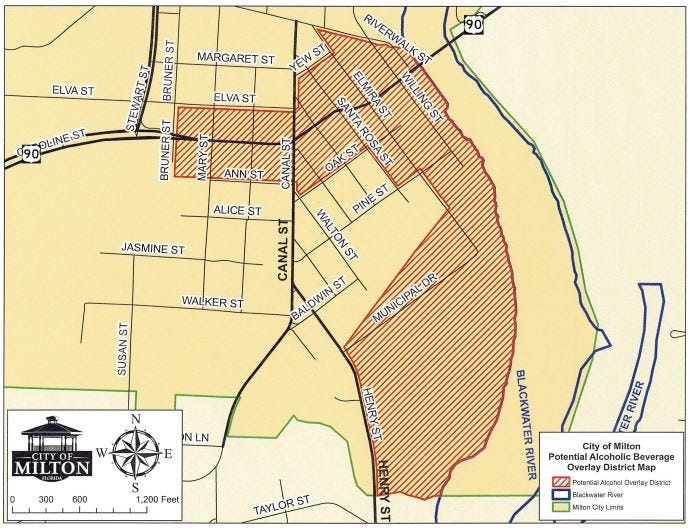![The potential Alcoholic Beverage Overlay District map provided by city of Milton staff. [Special to the Press Gazette]](http://127.0.0.1/wordpress/wp-content/uploads/2022/01/ghows-DA-5f9988b5-c1f0-07d2-e053-0100007f4c97-b78f0627.jpeg)
MILTON — At the Monday Executive Committee meeting, the committee discussed the Milton Planning Board’s recommendation to amend the Unified Development Code to provide for an Alcoholic Beverage Overlay District.
City staff provided the committee with draft alcohol district proposals with maps, which showed the recommended expansion of the overlay district to south of the railroad and east of Canal Street in non-residential areas.
During the discussion, Councilman Alan Lowery brought up the point that a lot of the area south of Municipal Drive belongs to Water Management and will not be developed, so City Manager Brian Watkins agreed that the overlay could be fixed to remove that area.
According to Planning Director Randy Jorgenson, previous discussions implied that some residents may want the law to allow bars or taverns to open at 11 a.m. at the earliest. Councilman Jeff Snow said he isn’t against making the time 11 a.m., but he knows some places serve mimosas before that time.
"I don’t understand why we’re making it different," Councilman Casey Powell said, referencing the time already in place — 7 a.m.
Lowery said he doesn’t have anything against the original time, but he knew some residents were against it.
Glen Hill, manager of the Blackwater Bistro in downtown Milton, said that in the past there were different hours set for different establishments until the county established one consistent opening time for bars and taverns, which is 7 a.m.
Councilwoman Heather Hathaway suggested keeping the 7 a.m. rule and letting business owners decide when they want to open.
Jorgenson said the ordinance in question only relates to bars and taverns, not establishments that sell food. As the ordinance stands, structures primarily used for residential purposes are not permitted to sell alcohol; however, if a structure within the ABOD that was once a home was bought and made into a bar, its use would be permitted.
Councilwoman Pat Lunsford asked how the distance rule came into play — a bar or tavern cannot be established within 500 feet of a church unless the church opts out of the ordinance. According to Jorgenson, the distance is from the front door of the bar to the front door of the church using the usual way a pedestrian would travel.
According to Watkins, there is currently no restriction on how many bars or taverns can be established in the overlay district. Resident Al Brewton said there should be, because the city doesn’t want its version of Bourbon Street (in New Orleans).
"We won’t have more than the community will support," Lowery said.
Theresa Messick, who lives in the historic district, asked the council how they would feel about living downtown with their children.
"How desperate are we that we go to bars and taverns?" Messick said. "We need to have compatible stuff… You need to reach out to the community to get input."
According to Jorgenson, there are a certain number of public hearings the city must hold before they pass the ordinance, which they plan to "vigorously participate in."
Hill said the ordinance is just to make sure certain businesses are established in certain places and not all over, like in Pensacola, and that the county shouldn't have any available liquor licenses at the moment.
Snow made a motion to accept the draft alcohol overlay district proposals with Lowery’s suggested amendments, and Lowery seconded the motion.
The motion passed with only Councilwoman Sharon Holley and Lunsford opposed.






This article originally appeared on Santa Rosa Press Gazette: City eyes Alcoholic Beverage Overlay District
